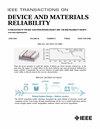Board Level-Component Solder Joints Normalized Crack Severity Index of Solid-State Drive With Different Reliability Temperature Cycle Test Profiles
IF 2.3
3区 工程技术
Q2 ENGINEERING, ELECTRICAL & ELECTRONIC
IEEE Transactions on Device and Materials Reliability
Pub Date : 2025-03-28
DOI:10.1109/TDMR.2025.3574447
引用次数: 0
Abstract
In the realm of electronic device manufacturing, one persistent challenge is the lack of a universal TCT (Temperature Cycle Test) solder joints crack assessment that is suitable for all types of electronic components. This gap becomes particularly complex when multiple components are assembled into a single board. Therefore, this paper proposed an approach by normalizing the solder joints cracks, index不同可靠性温度循环试验模式下固态硬盘板级元件焊点归一化裂纹严重指数
在电子器件制造领域,一个持续存在的挑战是缺乏适用于所有类型电子元件的通用TCT(温度循环测试)焊点裂纹评估。当多个组件组装在一块电路板上时,这种差距变得特别复杂。因此,本文提出了一种通过对焊点裂纹进行正火处理,以指数$\eta $值作为TCT后元件焊点裂纹的基准值的方法。这项工作使用了四种类型的组件,包括控制器,NAND,双数据速率随机存取存储器(DDR-RAM)和电源管理集成电路(PMIC)。所有这些组件都经过三种不同的TCT条件(A) - 40至85美元~{^{\circ}}}$ C, 10分钟浸泡,12.5分钟斜坡,500次循环,(B) 0至100美元~{^{\circ}} $ C, 15分钟浸泡,15分钟斜坡,750次循环和(C) 0至100美元~{^{^{\circ}} $ C, 15分钟浸泡,15分钟斜坡,900次循环,以确定SSD设计的相对严重程度及其关键组件的焊点性能。根据检验岗位DnP计算焊点裂纹百分率,并对其进行分析,比较其严重程度。计算了正火焊点的指数$\ mathm {{\eta}\}$,并对TCT后的所有元件进行了分析。结果表明,TCT型C对焊点裂纹的要求比TCT型A高4.1倍,比TCT型B高2.5倍。TCT型C的最高指数$\eta $值为5.2,与TCT型B的2.67和TCT型A的1.13相比,它是所有测试的TCT型中最严格的。这项研究的结果为选择有效的TCT剖面提供了有价值的见解,从而优化了测试程序,节省了时间和资源。这种方法对特定组件特别有利,包括控制器、NAND、DDR-RAM和PMIC封装。此外,使用指数$\eta $值作为基准度量标准正火焊点裂纹可以应用于其他类型的电子元件。
本文章由计算机程序翻译,如有差异,请以英文原文为准。
求助全文
约1分钟内获得全文
求助全文
来源期刊

IEEE Transactions on Device and Materials Reliability
工程技术-工程:电子与电气
CiteScore
4.80
自引率
5.00%
发文量
71
审稿时长
6-12 weeks
期刊介绍:
The scope of the publication includes, but is not limited to Reliability of: Devices, Materials, Processes, Interfaces, Integrated Microsystems (including MEMS & Sensors), Transistors, Technology (CMOS, BiCMOS, etc.), Integrated Circuits (IC, SSI, MSI, LSI, ULSI, ELSI, etc.), Thin Film Transistor Applications. The measurement and understanding of the reliability of such entities at each phase, from the concept stage through research and development and into manufacturing scale-up, provides the overall database on the reliability of the devices, materials, processes, package and other necessities for the successful introduction of a product to market. This reliability database is the foundation for a quality product, which meets customer expectation. A product so developed has high reliability. High quality will be achieved because product weaknesses will have been found (root cause analysis) and designed out of the final product. This process of ever increasing reliability and quality will result in a superior product. In the end, reliability and quality are not one thing; but in a sense everything, which can be or has to be done to guarantee that the product successfully performs in the field under customer conditions. Our goal is to capture these advances. An additional objective is to focus cross fertilized communication in the state of the art of reliability of electronic materials and devices and provide fundamental understanding of basic phenomena that affect reliability. In addition, the publication is a forum for interdisciplinary studies on reliability. An overall goal is to provide leading edge/state of the art information, which is critically relevant to the creation of reliable products.
 求助内容:
求助内容: 应助结果提醒方式:
应助结果提醒方式:


